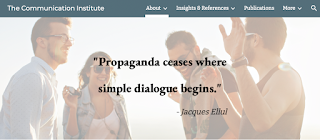What's mainly agreed about propaganda is that it's organized discourse that manipulates or deceives a large audience (see review of definitions in Marlin 2013, pp. 4-13). Everyday understandings range from what someone disagrees with (Baines, O'Shaughnessy, and Snow, p. xxv) through to puffery or hyperbole for promotion. Whether or not we like a cause, product, or person promoted might affect what we call propaganda, or what we feel about a propagandist's claim.
The explosion of research into the language and networks for fake news, disinformation, misinformation, conspiracy theories, and related during the last six years or so offers further insight about some aspects of propaganda. Some helpful suggestions for dealing with propaganda have emerged, suggesting for example when "prebunking" may blunt conspiracies (Lewandowsky and Cook, p. 8).
Key areas still require detailed exploration, as the editors of The Sage Handbook of Propaganda indicate, including "The effects of propaganda, particularly on democratic and authoritarian systems and on public opinion, over time" (Baines, O'Shaughnessy, and Snow, p. xxxvii).
In the 1930s, with:
...the global rise of fascist regimes who were beaming propaganda across the world, as well as US demagogues spouting rhetoric against the government and world Jewry, the rise of Stalinism, and the beginning of the Red-baiting that foreshadowed McCarthyism, scholars and journalists were struggling to understand how people could fall for lies and overblown rhetoric (Schiffrin).
Accordingly in 1939, Clyde R. Miller, who co-founded the Institute for Propaganda Analysis (IPA) with the support of Edward A. Filene in New York, said: "There are three ways to deal with propaganda–first, to suppress it; second, to try to answer it by counter propaganda; third to analyze it" (Schiffrin). Despite a backlash against the IPA with the approach of World War II, its principles and techniques helped people understand and deal with propaganda and influenced the considerable innovation in media-literacy training classes in US schools since. Yet, ever-better approaches are required.
Isn't it time we talked more about propaganda in the plural? As far back as 1962, this was an emphasis of Jacques Ellul, as he explored different types of propaganda, including pre-propaganda, sociological propaganda, covert and overt propaganda, vertical and horizontal propaganda, and so on.
To understand propaganda though, equally important is to recognize that propaganda is "heard" differently by different people. As David Sless and Ruth Shrensky point out in their recent book A New Semiotics, we each perceive words, images, music, actions, or events etc. differently–with each of us playing "...an active part in the making of the meaning..." (Sless and Shrensky, p. 46). Every one of us brings different projections and accommodations to what we perceive. Perhaps there are as many different propaganda as members of a large audience. Now, there's a challenge for empirical research! What we can be sure of is that different people give different connotations and denotation to a word, phrase, slogan, etc.
It's no more than a convenient illusion to think and act as if meaning is fixed in a word, phrase, image, or action and that everyone uniformly "gets it," much less that they should, or that it is the same "it." Compilers of dictionaries know this. We'll say that we go to a dictionary to clarify meaning. We rely on these fonts of information. Yet compilers of a dictionary just try to keep up with recording some more common uses of language. A dictionary records or summarizes usage, as an attempt to note meanings people might commonly give to words.
Acknowledging that meaning is not in messages but is created between an "author" and a "reader" requires us to rethink how we talk about any communication, including propaganda. Sless and Shrensky make important offerings on how we project our knowledge onto a sign (p. 48), how the concept of letness (derived from Immanuel Kant) describes our adoption of sensory data (p. 58), and that we are intrinsically engaged in meaning-making. When we attempt to describe our communication experience, it's not possible to stand apart independently as some might claim, much less to legitimately use the once-common critical artifice of an "ideal reader."
Even though there are many potential interpretations or meanings created, Sless and Shrensky do recognize shared public language or common meanings. They observe though that "it's hard to decide what may be shared" (p. 144). Their review of cause and effects models for communication is helpful (pp. 152-165) and is followed by concluding suggestions for revisiting how we perceive communication (pp. 170-175). It's people who give meaning to words or any "text," by creating understanding and knowledge. It really shouldn't be difficult in this age of iconic individualism to acknowledge that each of us brings our own contributions to meaning making. Such rethinking of how individuals in any sized audience "hear" what we call propaganda has some implications.
Firstly, we can reconsider ways to explore and expand what Ellul calls sociological propaganda, which he suggests is especially powerful. According to Sless and Shrensky, "you imbue with meaning the things that are significant to you by projecting and objectifying their significance" (p. 50). And we distill what's significant to us from our context of culture, experience, beliefs, and priorities.
If we value honesty, we're likely turned off by shady tactics in a public figure, but for the many who feel neglected and aggrieved by politicians, shady tactics and lying, or other dirty attacks against "others" and especially against so-called "elites" can be attractive, or even welcomed as fit retribution.
Beyond these two broadly different meanings created from the same propaganda, an array of meanings is created according to people's various experiences that shape belief about what's significant. So, social media or other so-called "message making" can't dismantle these meanings. Only a strengthened context of accountability for dishonesty combined with stepped-up opportunities for conversation and dialogue may sharpen doubt about the formulaic comments of propagandists.
Sless and Shrensky open the opportunity for us to tackle some interesting investigations. For example, how will we explore the multiple "authortexts" and "readertexts" (p. 118) beyond two people, within larger groups? Is this how we'll find better ways to encourage conversation, instead of the constant amplifying of social and political polarization?
Secondly, can we look beyond the assumptions of propagandists? Do we really want mental imprisonment in the world that propagandists seem obsessed with inventing? A propagandist or political party might treat democratic government as a joke (Lozada) or berate us with outrage and predictions of carnage. We should take heart that our own choices to think, speak, and associate freely empower us otherwise.
Thirdly, it's time to ask those who talk about human language as coding and decoding to think again. Creepy talk about computer coding being akin to natural language helps deliver the outlandish metaphor that AI is itself somehow "human-like"–with the marketing of AI also encouraging promise or fear (depending on your point of view) of AI substituting for human beings. In a straight line from the 1940s model for information transfer on the telephone, the analog of this code and decode metaphor is still used widely and integrated now with related aspirations in puffery for AI. It does NOT explain human communication.
Computing gives much to us but let's not humanize what human beings have created, which would also be self-demeaning and dehumanizing. Ironically, Apple's first advertisement for the Macintosh computer in 1984 promised automatons technological freedom [Link here].
An analogous challenge for a democracy is that propaganda to counter propaganda can help erode the basis of democratic government. As Marlin observed, Ellul pointed to the need for:
…liberal government to offset seditious ideas from within the state or …[use]… propaganda to offset other states seeking conquest over one’s own state. But he recognizes that once a state begins to engage seriously in propaganda, it erodes its own claim to being liberal (Marlin 2021).
In a liberal democracy, propaganda might be best suited to help deliver important short-term actions, such as getting out the vote. Strategies for dealing effectively with propaganda need to address how to strengthen the efforts of institutions like the judiciary, legislatures, education, and the media–to help evolve our culture, expectations, and individual freedoms of thought, speech, and association.
References:
"1984," Apple's Macintosh Commercial, https://www.youtube.com/watch?v=VtvjbmoDx-I
Paul Baines, Nicholas O'Shaughnessy, and Nancy Snow (Eds.) (2020), The Sage Handbook of Propaganda, Thousand Oaks, CA: Sage
Jacques Ellul (1965), Propaganda: The Formation of Men's Attitudes, New York: Knopf
Stephan Lewandowsky and John Cook (2020), The Conspiracy Theory Handbook. Available at http://sks.to/conspiracy also at:
Carlos Lozada (2022), "The Inside Joke That Became Trump's Big Lie," New York Times, September 22,
Randal Marlin (2013), Propaganda and the Ethics of Persuasion, Peterborough, ON: Broadview
Randal Marlin (2021), “Dynamic Tension for Pandemic Times,” Current Drift, 10 May, IJES Elul Society, ellul.org/current-drift/dynamic-tension-for-pandemic-times/ [also:
Anya Schiffrin (2018), "Fighting Disinformation with Media Literacy–in 1939," Columbia Journalism Review, October, 10,
David Sless and Ruth Shrensky (2023), A New Semiotics: An Introductory Guide for Students, London/New York: Routledge


.jpeg)
.jpeg)









